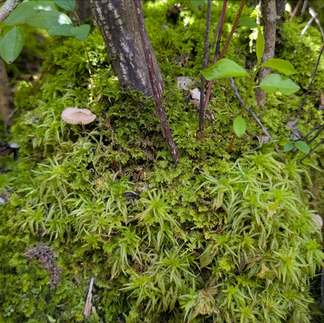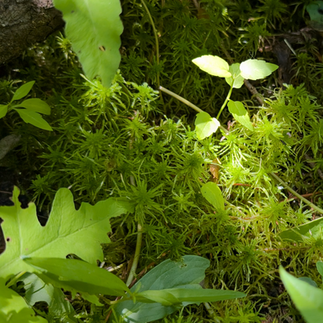Honoring Stacy Iwanicki | Native Plants of Volo Bog
- jkdenne
- Aug 6
- 3 min read

Friends of Volo Bog want to honor Stacy Iwanicki, the DNR naturalist who has been caring for the Volo Bog for over 35 years. Stacy has written so many insightful articles for the Bog Log newsletter to help visitors discover and appreciate the amazing native plants here. We’re excited to share these articles on our blog, and we're starting with her piece on Sphagnum Mosses from Winter 1998-1999. It’s hard to imagine Volo Bog without its incredible carpet of cool, wet sphagnum mosses!
Sphagnum mosses cover over 500 million acres of North America in habitats referred to variously as peatlands, bogs, fens, rich fens, poor fens, sphagnum lawns, intermediate fens, sedge fens, and muskeg. A small fragment of these fascinating habitats is contained right here in the Volo Bog. Here, in an old glacial kettle hole lake, sphagnum mosses (known also as peat mosses) have been growing together with sedges, shrubs and other plants. Due to the acid-producing properties of the moss itself, decomposition is slow (acids inhibit growth of bacteria). As each successive generation lives and dies, layer upon layer of peat (dead moss) accumulates as a floating mat that has been filling the lake for the past 6,000 years.
Uses for sphagnum: Sphagnum creates acidic conditions which inhibit the presence and growth of microorganisms. This creates an antibiotic property which contributes to the plant’s usefulness as a field dressing for battle wounds. Even more important in this regard is sphagnum’s absorptive property. During the First World War, one million absorbent, cotton-covered sphagnum pads were used each month by the British. The supply came from Scotland and Canada, which together produced in excess of 4 million each month! A half million of these were made in the United States where volunteers went out into the peatlands to collect the most absorptive species. Native American Indians used sphagnum as menstrual pads and diapers. Eskimos use it as boot liners which are not only warm but also odor-absorbing. They still gather and use moss in this way today.
In Europe, as peat is harvested, human bodies are often unearthed. To date, over 2,000 such bodies have been discovered, dating back over 2,500 years. Many of these bodies are believed to have been human sacrifices to ancient gods and goddesses. Their skin and hair have been perfectly leatherized by the acids of the peat soils.
The use of the word “harvest” is misleading, for it implies a readily renewable resource. Such is not usually the case. “Peat mining” is perhaps a more accurate term. Today, huge machines remove the peat where only decades ago, it was done by hand. Once removed, it can take hundreds to thousands of years for the peat to regenerate, depending on the local climate from which it was mined. Regeneration in the Midwestern U.S. is unlikely.
Visitors often ask if anything has ever been discovered preserved within the peat of Volo Bog. Core samples have revealed preserved pollen grains representing plants from 46 genera dating from over 11,000 years to less than 200 years old. Since we preserve what is living on the surface, we have never excavated peat more extensively than the small cores. Therefore, we have no way of knowing for sure. Folklore of the area tells of lost cows and horses that disappeared without a trace. It is quite possible that they could have ventured out onto the thin floating mat where they would likely fall through and become trapped. The same folklore also reminds us that mobsters were among the first settlers to move in “just up the street.” It leads to all sorts of speculation for interesting “what if” stories..."

You can read the full article and learn about the sphagnum life cycle and great book recommendations here. More books on mosses will be available at the Volo Bog's shop soon, so please stop by and check them out! All the beautiful photos are by Amy Runkle, who just joined our Friends of Volo Bog Board. She took them during the International Bog Day on July 27, 2025 at Volo Bog.

















Comments